The 8 Best Indoor Activities for Blind Kids

This post may contain affiliate links; please see our terms of use for details.
- Finding fun activities for your visually impaired child can be a challenge, especially when you are hit with a sudden rain or snow storm and are stuck inside all day!
- But a visual impairment shouldn’t prevent you from finding creative ways to keep your child entertained while also encouraging exploration and development.
- From bath tub ball pits to adding textures to play doh prints, there are so many ideas for accessible indoor play!
There are some days when the weather just doesn’t cooperate. When it’s rainy and dreary outside, it’s tough to come up with something fun to do while trying not to feel like you are cooped up inside. If you have a blind child, finding activities to keep them occupied can be even more challenging.
However, there are plenty of great engaging indoor activities to choose from! Whether you’re looking for educational games that teach essential life skills or just want some fun ideas to keep your child entertained on a rainy day, these eight activities are sure to please. So get ready to have some fun!
1. Make Music
Use musical instruments or your voice to make some noise. Music is an ideal way for your child to express themselves and have fun.
Don’t have instruments? No problem! You can use everyday objects around the house to make music. For example, you can bang on pots and pans with wooden spoons, shake maracas made from empty water bottles filled with rice or beans, or blow into empty soda bottles to make a trumpet sound.
Get creative and see what kinds of sounds you can come up with!
If you want to take things up a notch, you could try making instruments from recycled materials, like making a hand-held drum out of paper plates or an ocean drum out of an old box. Once you’ve made your instruments, have a jam session with your child and enjoy creating beautiful (although sometimes cacophonous) music together.
2. Draw and Color
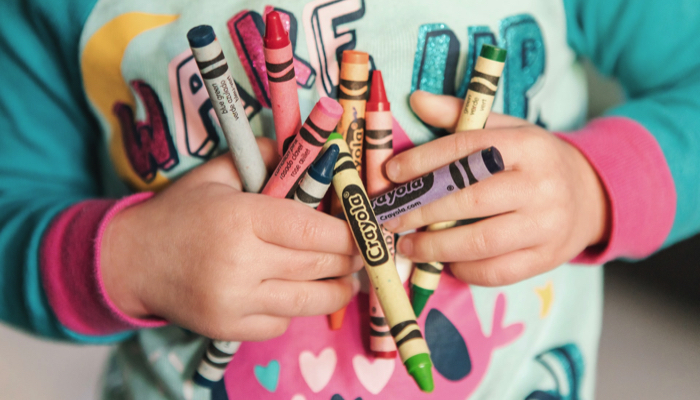
There are a lot of fabulous coloring books out there specifically designed for blind kids. These books often have raised lines or special textures that your child can feel as they color in the picture. Coloring is an excellent way for kids to develop their fine motor skills and be creative.
If you don’t have any specialized coloring books, regular ones will work fine. Just be sure to use thick markers or raised puffy paint to enhance the lines so your child can easily feel the lines they are coloring within. Kids with low vision do well with simple large print coloring pages.
You can also try other drawing activities like using a lightbox to trace images or placing textured materials under your paper to create your own tactile images.
Did you know that braillers can also create pictures? Older children who are learning braille may enjoy trying their hand at drawing with their brailler and using the raised dots to make images rather than words.
3. Get Moving

Dancing, jumping on a trampoline, playing in a body sock, or just running around the house is a great way to get active when you are stuck indoors. It’s also a lot of fun!
Exercise is essential for everyone, but it’s especially important for blind children because they often don’t get the opportunity to explore their environment and move around as much as sighted children do.
So put on some music and start a dance party! Your child is sure to have a blast. You can also try other active games like tag, Simon Says, or Red Light Green Light.
Even kids in wheelchairs or with mobility challenges can benefit from some movement activities. Ivan loves to participate in chair yoga which encourages stretching while sitting. Sitting on the floor while rolling a ball back and forth is another simple way to get in some movement. Beeping balls or balls with bells in them work great for children who are blind.
4. Bake Something
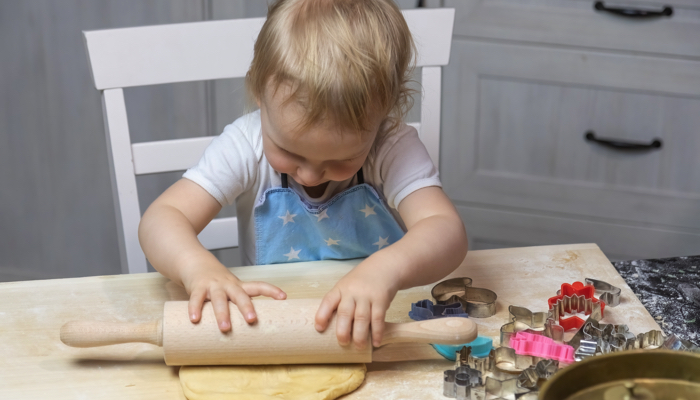
Why not put your culinary skills to the test by making cookies, cakes, or even pizza? Baking is a great activity for blind kids because it helps them develop their sense of touch and smell and helps them learn essential independence skills in the kitchen. It’s also a fun way to spend time together as a family.
Plus, your child will be able to help measure out the ingredients, which is an excellent way for them to practice their math skills. Just be sure to provide plenty of supervision and assistance when working with hot ovens or stovetops.
Baking is also a fantastic opportunity to teach your child about food safety and hygiene.
If you’re not into baking, you can always try cooking something simple like popcorn or mix nuts and raisins to create your own trail mix flavor.
Whatever you decide to make, cooking together is sure to be a fun and memorable experience for both you and your child.
5. Read Stories

Audiobooks or books with Braille labels can both be fun. You can find a wide variety of books specifically designed for blind children at your local library or online.
If you don’t have any specialized books, you can always use regular print picture books. Just be sure to describe the pictures to your child as you’re reading so they can understand what’s going on in the story.
Another fun way to make stories more accessible is to create a story box. Find everyday objects around your house that can represent items mentioned in your story. Books based on long lists (like If You Give A Mouse A Cookie) work great as story boxes! This makes the story come to life for kids with visual impairments, and it can also be a fun activity to involve your child in finding the objects in the book.
You can also try making up your own stories. This is a great way to encourage your child’s imagination!
6. Take a Ride On a Scooter Board
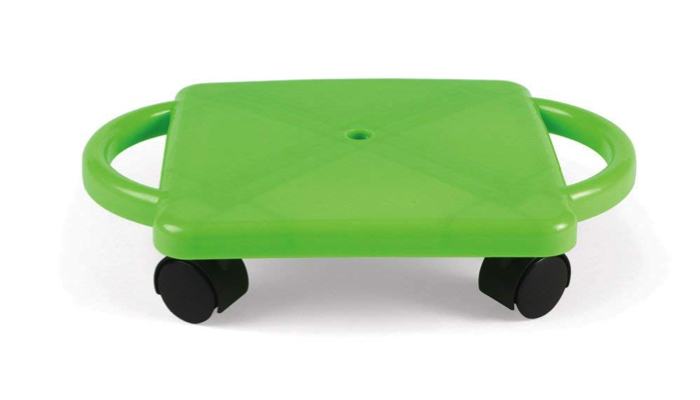
If you have hardwood floors, scooter boards are a fun indoor activity for visually impaired children. Your child can ride around on the board and use their feet and legs to propel themselves forward. Or maybe they can try laying on their stomach and using their hands to move the scooter.
Scooters are an excellent way for kids to get some exercise while indoors while also working on those gross motor and coordination skills. Just be sure to supervise them closely as they ride around, because those small wheels can pinch little hands!
If you don’t have hardwood floors, you can still let your child ride a scooter board by placing a yoga or rolling chair mat down first. This will provide a firmer surface to ride on and give them more traction when propelling on carpet.
7. Go for a Swing
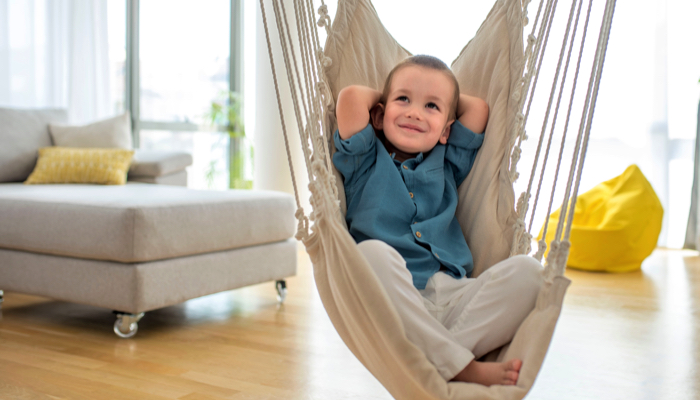
An indoor sensory swing can be a sensory and developmental powerhouse for a child who is blind. Swinging helps to develop proprioception, which is the sense of where our bodies are in space. This is especially important for children who are blind, as they may not have as many opportunities to develop this sense.
The feeling of the wind on their face can also be very sensory stimulating for children. In addition, swinging can help develop vestibular processing skills, which are essential for maintaining balance and coordinating movement. Also, the rhythmic motion of swinging can be very soothing for a child who is blind and can help to calm and focus them.
It’s also just a really fun activity that doubles as exercise!
8. Play with Water Beads
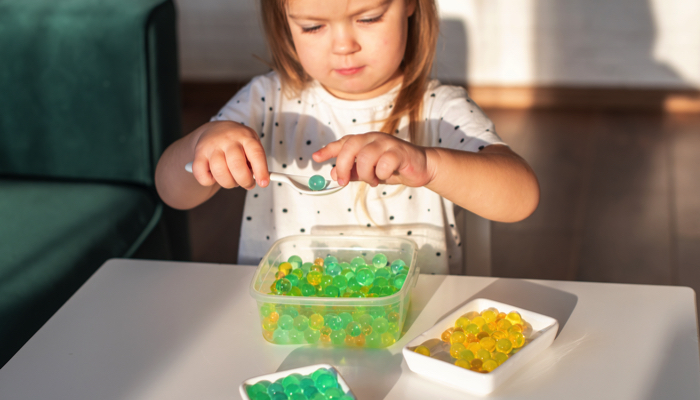
Water beads are small, colorful beads that are made from water-absorbing polymer. They feel squishy and slippery, and they’re a lot of fun to play with.
Water beads can be used in various ways and are a great sensory activity for blind children because they provide tactile stimulation and can help children develop their sense of touch.
If you want to try something different, you can freeze the water beads overnight and let your child play with them the next day. They’ll love feeling the cool, slippery beads as they slide around in their hands.
There are many other fun activities that blind children can enjoy. Get creative and see what you can come up with! Whatever you do, just have fun and enjoy spending time with your child. After all, they’re only young once!
Looking for more rainy day activities? Try these!
- Make your own light table
- Try some accessible preschool crafts
- Bring out a sensory play kit
- Make your own toys
- Create a big (or small) play space
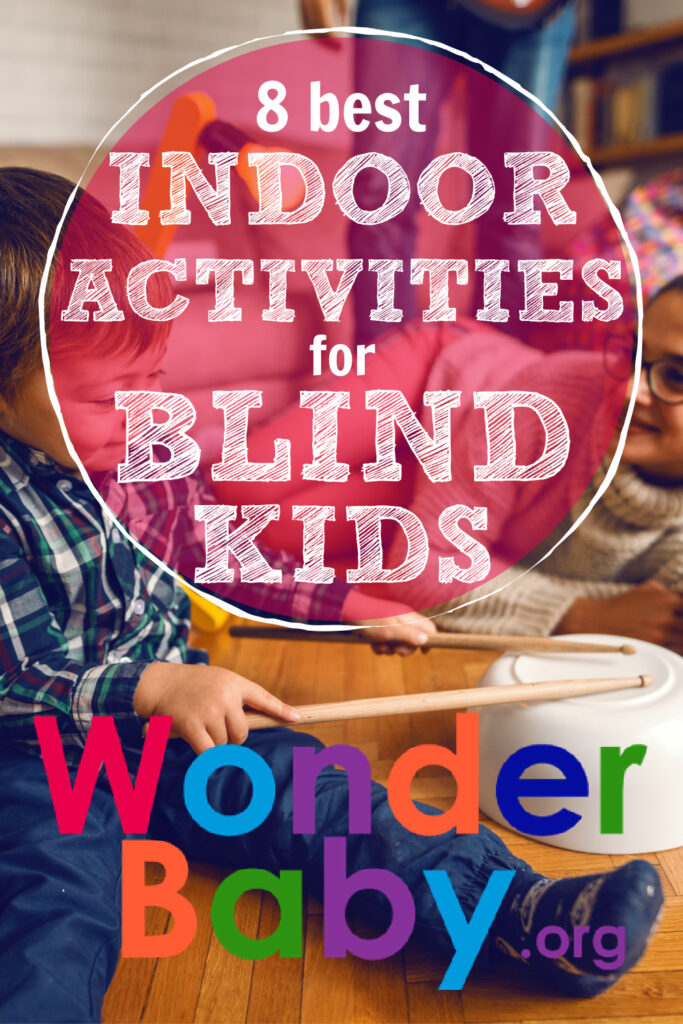
Related Posts

Eye Conditions and Syndromes, Visual Impairment
Neuralink Announces Plans to Restore Sight to the Blind with Brain Chip
Elon Musk’s company Neuralink has announced plans to begin human trials of its new “Blindsight” brain chip by the end of 2025.

Visual Impairment
The Gift of Understanding: How a Young Child Helps His Blind Father Navigate Life
When a parent is blind, it’s natural for people to wonder how their sighted child will adapt. Will they struggle to understand their parent’s needs? Will they feel burdened by...

Braille and Literacy, Toys, Visual Impairment
24 Braille Toys for Kids Who are Blind
Everything from alphabet blocks to raised line coloring pages and activity books to puzzles to card and board games... and so much more! And it's all in braille ready for...